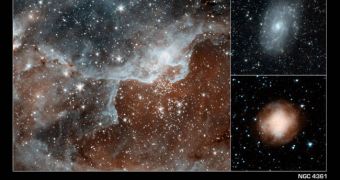The Spitzer Space Telescope is one of NASA's four Great Observatories, which also include Chandra, Hubble and the former Compton observatory. Launched in 2003 aboard a Delta II rocket, its goal is to survey the Universe in infrared wavelengths. However, in order to do that, it needs to be cooled close to absolute zero. Later this year, on May 15, after exceeding its estimated operation time by more than twice, its coolant reserve was depleted, and it began its Warm Mission. Now, Spitzer beams back the first photographs it took at reduced sensitivity.
For those of you who imagine that Spitzer is now warm enough to bake potatoes on, experts remind that the instrument still operates at about -243 degrees Celsius, or -406 degrees Fahrenheit. This allows for the two shortest wavelength modules of the Infrared Array Camera (IRAC) camera to still function. Presumably, mission controllers say, these two sections of the device will continue to operate if the telescope maintains an overall temperature lower than 30 degrees Kelvin.
“The performance of the two short wavelength channels of Spitzer's Infrared Array Camera is essentially unchanged from what it was before the observatory's liquid helium was exhausted. To put that in perspective, that means Spitzer's sensitivity at those wavelengths is still roughly the same as a 30-meter ground-based telescope,” explains Spitzer program scientist Doug Hudgins, from the agency's headquarters in Washington DC, Space informs.
The first pictures it took at the new temperature levels were of the Cygnus region inside the Milky Way, which is an extremely potent stellar nursery. However, like all such formations, it is surrounded by vast amounts of gas, as are the stars that are formed inside. Infrared wavelengths can penetrate cosmic gas and dust, and Spitzer imagined this stellar nursery, the planetary nebula called NGC 4361, as well as the classic spiral galaxy called NGC 4145, which is located about 68 million light-years away.
“With Spitzer's remaining shorter-wavelength bands, we can continue to see through the dust in galaxies and get a better look at the overall populations of stars. All stars are equal in the infrared,” concludes Spitzer imaging specialist Robert Hurt. He is based at the California Institute of Technology (Caltech) Spitzer Science Center, in Pasadena, California.

 14 DAY TRIAL //
14 DAY TRIAL //